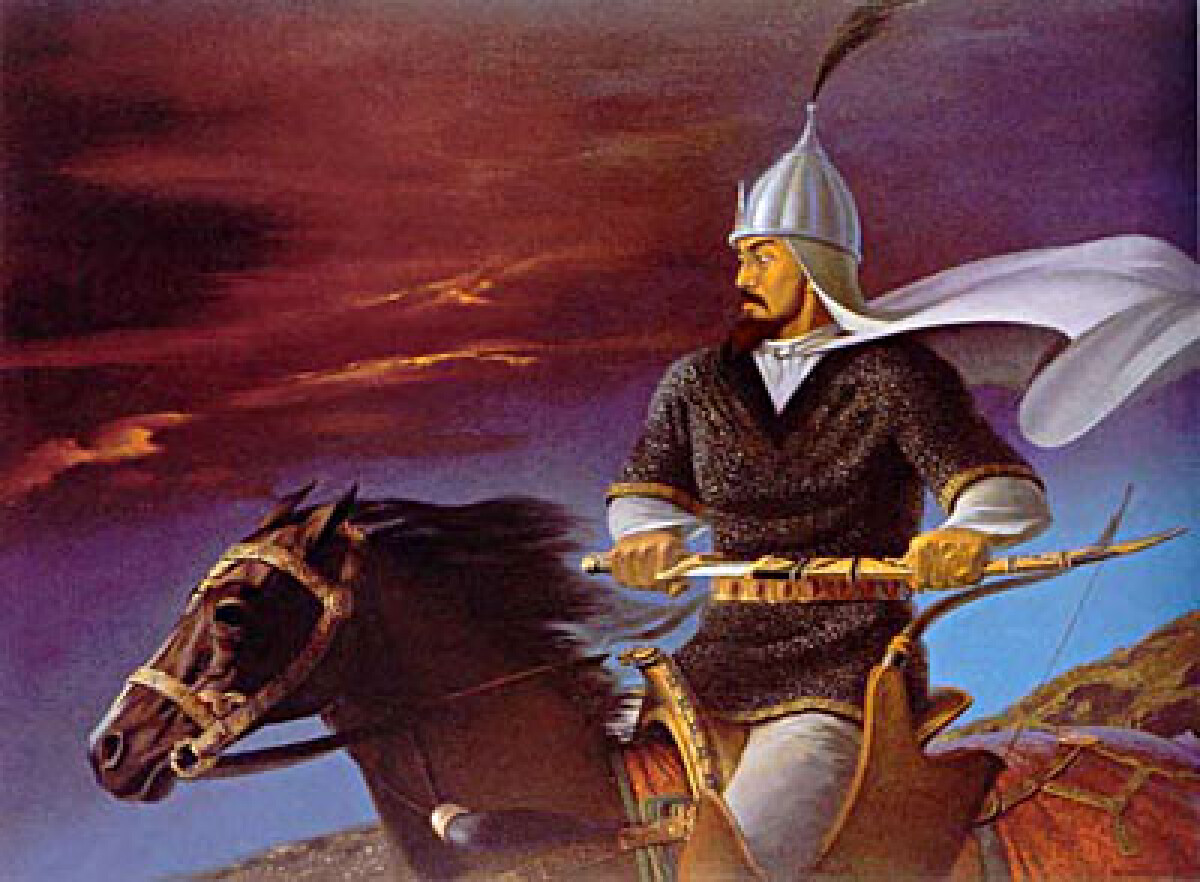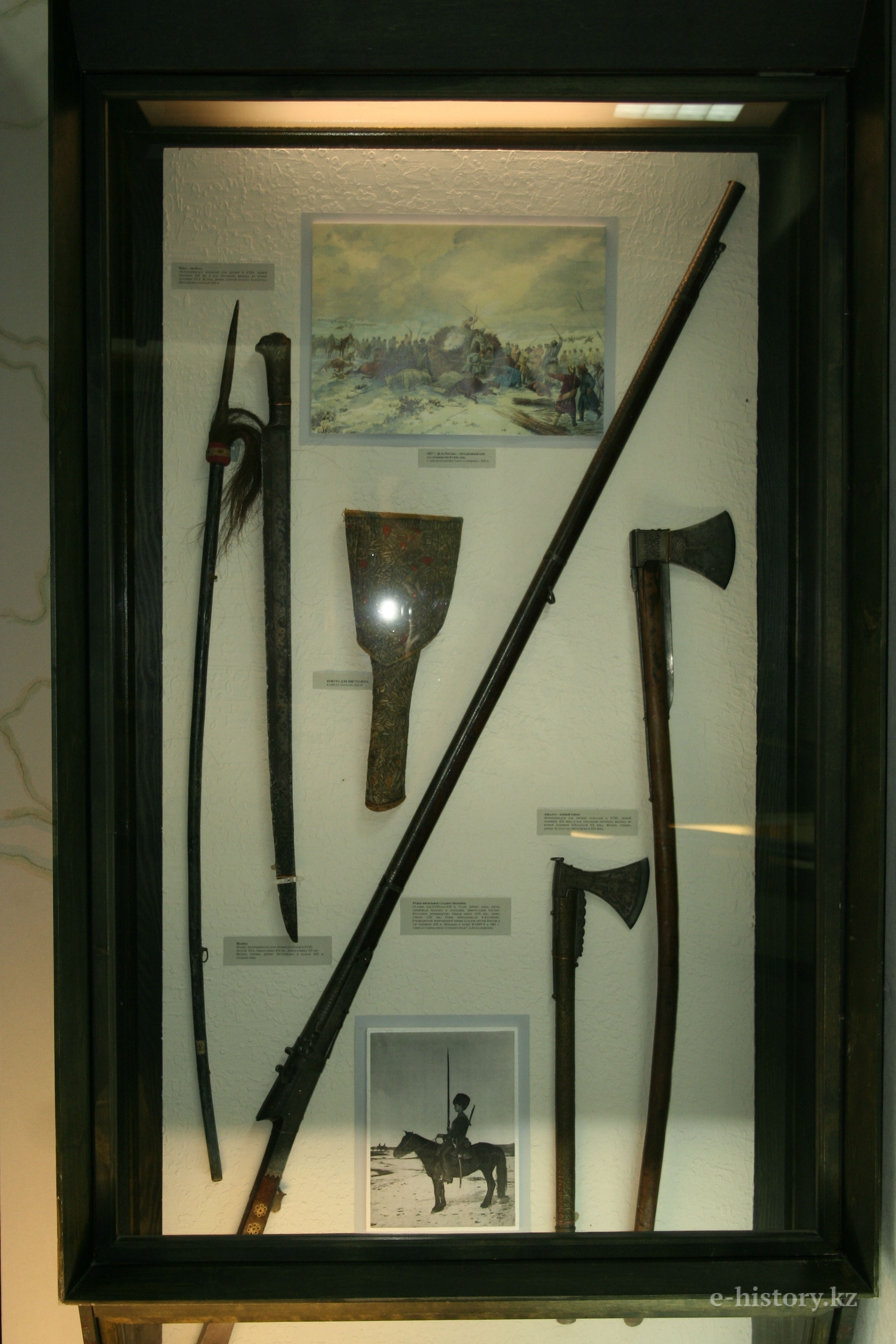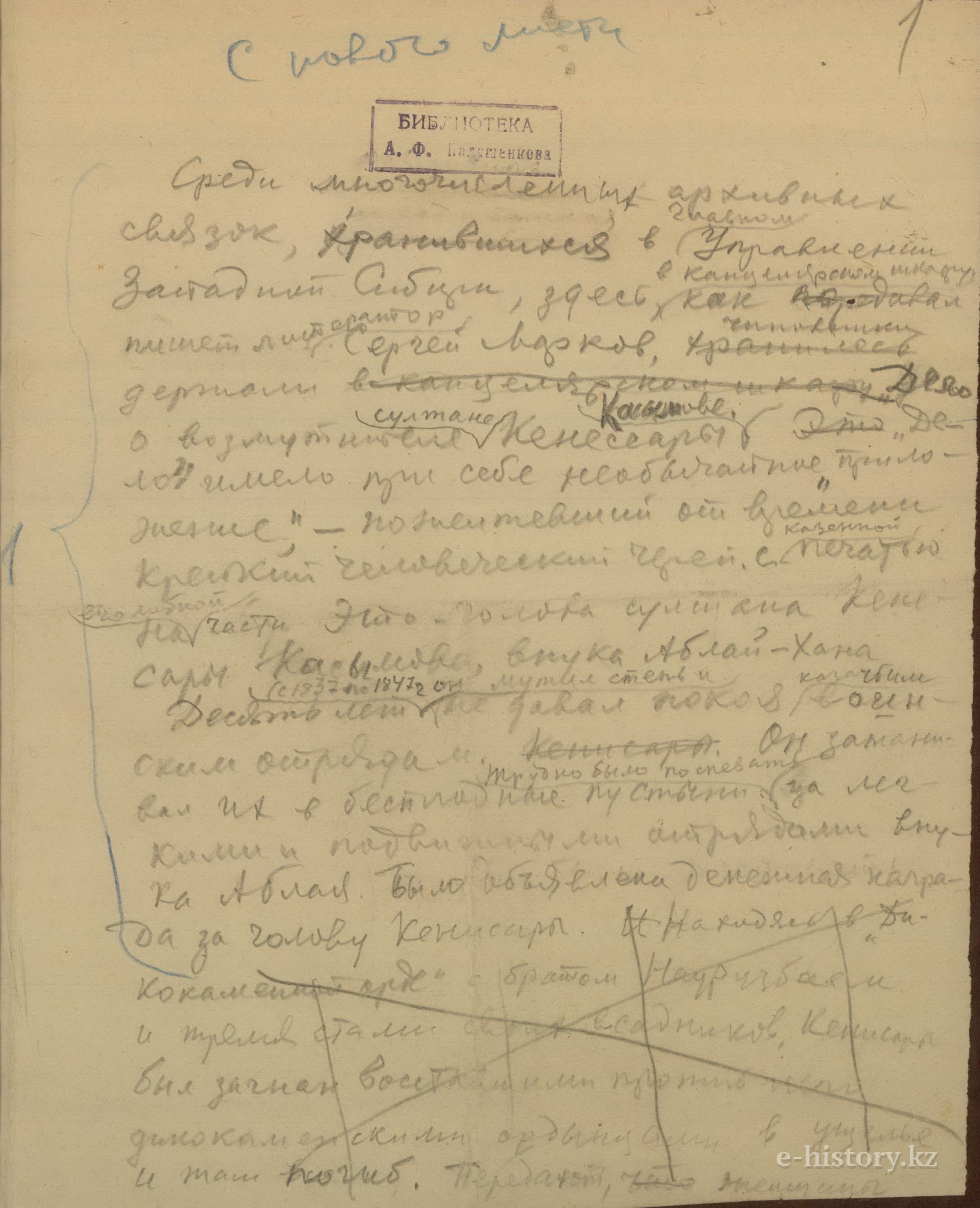
In a number of archive cases about revolt of the khan Kenesary Kasymuly (Kasymov) 1837–1847 which are in fund of the State Historical Archive of the Omsk Region (SHAOR) not so long time ago was found mysterious signature stamp of chipboard that sharply limits access to these documents, especially for scientists from Kazakhstan. Nevertheless, on document found in SHAOR refutes many legends and conjectures of destiny of a skull of the rebellious Kazakh Khan Kene.
For the first time the thought about the need to continuing the search for a subsoil of Omsk arose in 2009 after a week of work in Petrovsky Cabinet of curiosities and the Hermitage in St. Petersburg. Details and results of this trip were explained in the article «Traces of Remains of Last Kazakh Khan leads… to Omsk». The author never purposely was engaged with a subject about revolt of the Kenesary Khan, especially about tragic destiny of his head after lass in 1847. However, in 1991 for the first time and unexpectedly he faced with it during compilation of the collection «Alikhan Bokeikhan. Tandamaly — Selected» (Almaty: Kazakh encyclopedia, 1995).Then the question about authorship of the brochure «Materials to history of the sultan Kenesara Kasymov» behind the signature K. Stepnyak under edition of a certain professor Polivanov and Halel Dosmukhamedula (Dosmukhamedov) rose. These materials were included into the collection of the selected compositions of A. Bukeykhan in spite of the fact that remained small, but still doubt concerning pseudonym accessory K. Stepnyak to the leader of movement «Alash».
To remind that this brochure, according to the eyewitness Kyrgyz Kaligulla Alibekov, circumstances of tragic loss of the sultan Kenesary and also episode of delivery and transmission of his skull in Omsk to the governor general of Western Siberia in 1836–1851 prince Pyotr Gorchakov were described.
Later the meeting with the famous writer, the journalist-researcher, now deceased Amantay Satayev, who devoted a lot of time to study of a subject about revolt of Kene Khan, in particular to search of his head, in a root changed author’s attitude towards this legendary historic figure. Since that time the idea about continuation of search of remains of the last Kazakh Khan who literarily and figuratively sense gave his head for restoration of the unity of Kazakh national state despite that the Khan’s institute became obsolete, and restoration of its former greatness was in the fantasy.
It is necessary to emphasize that the A. Satayev carried the researches in Soviet period, in the 60–80 years, seriously risking getting to disgrace in the eye of retaliatory department of communist regime as KGB, such steps for any brave person could be end up in «mental hospital». Author due to some circumstances already during the days of national independence and in case of a full freedom of action, had to return to this subject only incidentally. He also admits that continuation of A. Satpayev’s case was carried in parallel with research of history of national liberation movement «Alash» in the beginning of the 20th century and its leader A. Bukeykhan. The last expedition to Omks was not an exception. The doctor of historical sciences, the director of institute of the humanitarian researches «Eurasia» of Eurasian National University (ENU) of L. N. Gumilyov, Ziyabek Kabuldinov, the ethnographer, the candidate of historical sciences Sulushash Kurmanova and the doctoral candidate of ENU of L. N. Gumilyov and the research associate of scientific research institute «Alash» Erkin Rakhmetullin took part in expedition.
In a number of establishments in Omsk, in particular in Omsk State Museum of History and Regional Studies, especially their principals tried to convince the author of these lines of the State Historical Archive of the Omsk Region (SHAOR) where this expedition worked, that information on finding of a skull of the sultan Kenesara Kasymula in OGIK the museum or GIAOO after handing to his prince Pyotr Gorchakov, no more than a legend, isn’t known whom widespread, but not having under itself any bases.
In the number of institution in Omsk, particularly in Omsk State Museum of History and Regional Studies (OSMHRS), especially in the State Historical Archive of the Omsk Region (SHAOR) where this expeditions conducted their work, the leaders of them tried to convince the author that information about finding of Kenesary Khan’s skull in OSMHRS or SHAOR after handing it to prince Pyotr Gorchakov, no more than a legend, unknown by whom was spread and has not got any bases.
It is important to highlight that being interested in further destiny of remains of Kenesary Khan in archive and the museum in Omsk same as in St. Petersburg in 2009 the members of expedition did not set as the purpose by all means to find a subject of searches, but to find out answers for important issues like: when precisely before and after revolution of 1917, under whose order or instruction, where and by whom it was transferred?
The sensational interview of the academician Yury Horoshilov, former director of Museum fund of Academy of Sciences of the USSR published in the Kazakh newspaper «Express-K» on February 7, 2003 where he declared that Kenesary’s head in Soviet period was stored in Gokhran of the USSR, and now — in Gokhran of Russia, despite the sensational nature, does not give the answer to none of these questions. It is important to note that in Reference and Bibliographic Department of the Russian State Library (RBD RSL) of traces «bulletins of Museum fund of Academy of Sciences of the USSR with lists of exhibits» about which in interview «Express K» was said by the academician Horoshilov where, according to him, as if Kenesary Khan’s remains and his battle flags at present were not found. In «the Bulletin of Moscow State University (MSU), Series 8. History», since 1946 until 2012 inclusively, any publications Yu. Horoshilov about Kenesara Kasymula’s revolt (in the interview the author speaks «about colonial revolt of the 19th century») and, the most important the information about further destiny of its remains was not found.
Meanwhile meetings and conversations with one of the former employees of OSHR museum Sergey Pervyh, the director of Omsk branch of the Russian fund of culture Alexey Sorokin and the local historian Alexander Losunov encouraged and, mainly, convinced us of need of further work on the given subject. Some of them gave valuable information on, where and what to look for. But dealing with funds, to be precise with directories of SHAOR funds, expedition encountered unpleasant «innovation». In particular, on some archival concerning revolt of the sultan Kenesara Kasymula (the name of the rebellious sultan quite often appear in affairs as «Kenesary», «Kenisary», «Kasimov», «Kasymov» is more often) and therefore brought in us a particular interest, at first sight, mysterious signature stamps of «chipboard», and in many — «EV» were put down. Later the staff of archive explained abbreviations of phrases «For the Official Use» and «Especially Valuable».
Among them especially the sign «chipboard» appeared the unpleasant «know-how» which involuntarily reminded a notorious Soviet signature stamp «top secret». Especially to the author of these text who has more than 20 years' experience in archives of Russia — St. Petersburg, Moscow, Orenburg, Omsk, Samara and other cities, and in both cases during USSR and after its decay, it was necessary to face for the first time in 20 years with similar «phenomenon».
For example, archive of KGB of USSR of 1991, archive of Kazakhstan’s KGB of 1992 and FSB of Russian Federation of 1995 (in 1995 also FSC — Federal Service of Counterintelligence) — the most closed state departments of 2014. As in SHAOR all affairs marked by a signature stamp of chipboard are given exclusively with permission of the first principal of establishment. Whereas intelligence services USSR, Kazakhstan and Russia according to the first written address provided to the author of this text the copies of documents from once «absolutely confidential» cases and KGB of Kazakhstan of 1992 — allowed to the work in the archive without excess formalities.
Also it was strange that the cases related to the participation in history of more one and half century — to the period of revolt of the Kenesary Khan — the first half of 19th century.
Meanwhile the director of SHAOR for whom we applied for permission, unfortunately, just next day after our visit to archive, went on the deserved summer holiday…. Some guilty responses of ordinary employees of SHAOR, «as we were told, so we also made: address to the management board», and the response of executive duties director that «only director can give a permission after vacation», only strengthened by our bewilderment. Apparently, the similar phenomenon arose just recently and probably that it is not generated from own initiative of SHAOR, but after instruction from board of management it is not exclude that from Moscow.
The case with a signature stamp of «EV» was not pleasant as copies of necessary archive documents cost a lot of money for scientist from Astana.
Nevertheless the personal archive of Andrey Palashenkov better known among local historians as «Palashenkov’s Fund» appeared a quite good consolation. In particular, from Palashenkov’s fund, certainly, two yellow papers with the hand-written text written by a pencil showed great value. This manuscript is more similar to a sketch of the notice or article which, obviously, remained incomplete. Most likely, the author was going to write about Kenesary Kasymuly’s destiny.
The contents of the manuscript which will hardly leave someone indifferent: «Among the numerous archive sheaves stored in Head Department of Western Siberia, here in office as the writer Sergey Markov writes, officials held case of Kenessary Kasymov disturber sultan, testifies it.
„The case“ had extraordinary „appendix“ — the STRONG HUMAN SKULL WHICH TURNED YELLOW FROM TIME WITH THE STATE PRINTING ON ITS FRONTAL PART (!). It is SULTAN KENESARY KASYMOV’S HEAD, the GRANDSON OF ABLAY-KHAN…» (SHAOR: fund 2200 («Palashenkov’s fund»), inventory 2, case No. 888, sheet 1).
Before drawing conclusions from this quote, it is worth paying attention to the identity of the author of these lines and to the one whom he quotes.
Andrey Palashenkov (1886–1971) — the Russian scientist, the local historian, the ethnographer, the museum staff, the most known of Omsk local historians, after an early release from Karlag in 1936 until the end of life lived in Omsk. From 1937 to 1943 OSHR the museum worked as the research associate of Omsk local museum, nowadays, in 1943–1957 was its director.
Sergey Markov (1906–1979) — the Russian Soviet poet, the prose writer, the historian, the geographer, the traveler, the archivist, the ethnographer — in the 1920 lived in Akmola, Petropavlovsk and Novosibirsk. The first compositions — verses, feuilletons and notices, he started publishing in 1921–1924 in the Akmolinsk newspaper, then up to 1928 began to be published in periodicals of Petropavlovsk, Omsk and Novosibirsk. The author traveled a lot, from 1930–1932 had been visited Central Asia. As a result, in addition to many works of art, he wrote the historical and bibliographic story about Chokana Valikhanov which was published in 1963 in Almaty in «Kazgoslitizdat» in the collection under the name «Going to Peaks».
From what composition the writer S. Markov provided A. Palashenkov’s above-stated quote, was not identified. But, according to the biographic data of these two ethnographers, there is a single result: before revolution of 1917 up to 1930, the head of the Kazakh Kenesary Khan did not leave borders of Omsk, and it was attached to the case of «disturber» as «extraordinary application». According to the S. Markov’s description, he saw this business together with application and testifies that «on its frontal part» there is «the state printing». However neither in OSHR museum, nor in SHAOR this case has not found yet.
But it is not exclusion that «the case of disturber sultan Kenesary Kasymov» is just among those affairs which have that ill-fated signature stamp of chipboard and under other name. It is impossible to exclude considerable probability that this case remained without the «extraordinary application» if it really was transferred to Cabinet of curiosities of the Hermitage, from where it transferred to scientific research institute of ethnos and an origin of the person, which then, on improbable combination of circumstances, to get at first in Gokhran of the USSR, then to Gokhran of the Russian Federation as about it in interview to the Express-K newspaper the academician Yu. Horoshilov claimed.
However, when and how Kenesary Khan’s head got to Cabinet of curiosities, he does not specify. Nevertheless there is one more conclusion that despite where the head of sultan could be, it has significantly differentiate from human remains — «the state printing on its frontal part».
One of the terrible conjectures that from the skull of Kazakh khan rebel an ashtray was made for the Russian monarch at his request was refuged by the evidence of S. Markov on existence of «the state printing on its frontal part».
Moreover, in OSHR museum there is a gun of the rebellious sultan Kenesary Kasymula. Author admits, it not a finding of «Omsk expedition», it is an exhibit of the museum already more than a century. The gun was presented as a gift to the first Governor General of the Kazakh steppes Gerasim Kolpakovsky in 1882, 35 years later after tragic loss of Kenesary Khan.The General Kolpakovsky presented it at the same year to the museum of the West Siberian department of Imperial Russian Geographical Society (IRGS).The expedition could only manage to find out the name of generous donator, he was the Kazakh named M. Dusentayev. The draft copy of the inventory on historical-revolutionary department (weapon) of the Omsk edge museum of1927 provided to the author of these lines by Sergey Pervyh, who was long time the employee of the OSHR museum, testifies it.
Preliminary results of Omsk expedition are restricted for a while with this finding and several, but very important outputs so far. Searches of responses on listed above and on many other questions in Omsk will be by all means continued. To these searches, but already in Moscow and St. Petersburg, it would be time to be connected resolutely and to the government of Kazakhstan to confirm the statement of the former director of Museum fund of Academy of Sciences of the USSR Yury Horoshilov, or finally to refute that the head of the Kenesary Khan Kasymuly and banners of his army are in Gokhran of Russia. He also declared that «the general list of the „souvenirs“ which are carried away then by the Russian sotnik (military rank) from the Kazakhstan steppes — is about three hundred subjects» that «in case of a due pressure and aspiration to resolve this issue at the state level it will turn out quickly and without vanity».
Sultan Khan Akkuly
Director of Scientific Research Institute «Alash» of Eurasian National University named after L. N. Gumilyov



